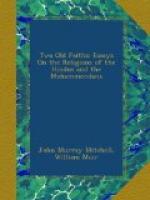Mr. Sen’s influence was naturally and necessarily great; but in opposing the venerable leader of the original Somaj he had set an example which others were quite willing to copy.
[Sidenote: Discontent growing.] Several of his followers began to demand more radical reforms than he was willing to grant. The autocracy exercised by Mr. Sen was strongly objected to, and a constitution of the Somaj was demanded. Mr. Sen openly maintained that heaven from time to time raises up men endowed with special powers, and commissioned to introduce new forms or “dispensations” of religion; and his conduct fully proved that he regarded himself as far above his followers. Complaints became louder; and although the eloquence and genius of Keshub were able to keep the rebellious elements from exploding it was evident, as early as 1873, that a crisis was approaching. This came in 1878, when Mr. Sen’s daughter was married to the Maharaja of Kuch Behar. The bride was not fourteen, and the bridegroom was sixteen. Now, Mr. Sen had been earnest and successful in getting the Brahmo Marriage Act passed, which ruled that the lowest marriageable age for a woman was fourteen, and for a man eighteen. Here was gross inconsistency. What could explain it? “Ambition,” exclaimed great numbers; “the wish to exalt himself and his daughter by alliance with a prince.” But Mr. Sen declared that he had consented to the marriage in consequence of an express intimation that such was the will of heaven. Mr. Sen denied miracles, but believed in inspiration; and of his own inspiration he seems to have entertained no doubt. We thus obtain a glimpse into the peculiar working of his mind. Every full conviction, every strong wish of his own he ascribed to divine suggestion. This put him in a position of extreme peril. It was clear that an enthusiastic, imaginative, self-reliant nature like his might thus be borne on to any extent of fanaticism.
[Sidenote: Revolt; a third Samaj. “New Dispensation.”] A great revolt from Mr. Sen’s authority now took place, and the Sadharan Samaj was organized in May, 1878. An appeal had been made to the members generally, and no fewer than twenty-one provincial Samajes, with more than four hundred members, male and female, joined the new society. This number amounted to about two thirds of the whole body. Keshub and his friends denounced the rebels in very bitter language; and yet, in one point of view, their secession was a relief. Men of abilities equal, and education superior, to his own had hitherto acted as a drag on his movements; he was now delivered from their interference and could deal with the admiring and submissive remnant as he pleased. Ideas that had been working in his mind now attained rapid development. Within two years the flag of the “New Dispensation” was raised; and of that dispensation Mr. Sen was the undoubted head. Very daring was the language Mr. Sen used in a public lecture regarding this new creation. He claimed equality for it with the Jewish and Christian dispensations, and for himself “singular” authority and a divine commission.




